In-Depth with Mac OS X Lion Server
by Andrew Cunningham on August 2, 2011 8:00 AM ESTA directory isn’t much good to anyone without any objects in it, so we’re going to create a few users and groups to test things out. As with creating a directory, there are a couple of different ways to do it.
In Server.app: Use the plus sign to add new users in the Users section - you can enter their full name, email address, and desired password here, which covers most of the account basics.
Directory accounts (as opposed to accounts local to your server) will appear with a circular blue globe icon next to their names.
Clicking the gear icon will allow you to edit the user’s properties (including the full name, email address, whether he or she can administer the server, and group membership - the user’s short name isn’t changeable after it’s set), as well as edit the services that user can use (making it easy to keep, say, mail or VPN access off-limits to guest users).
Start Workgroup Manager and authenticate using the Directory Administrator privileges you specified when you created your directory. The window you’ll see is a bit scarier than what you get in Server.app.
The four tabs above the left-hand column are for users, user groups, computers, and computer groups - if you made some users or user groups in Server.app before, they’ll show up here, too, and you can enter a lot more info in Workgroup Manager than in Server.app. There’s too much to go into in a general review, but this screenshot will give you an example of the detail you can go into:
The main thing you can do with Workgroup Manager that you can’t do with Server.app is manage OS X preferences - everything from the icons in the Dock to what applications your users are allowed to launch. If you select a user or group or other entry, you can click the Preferences button to see all of your options.
Settings in here are roughly analogous to those in System Preferences in any ol’ Mac.
Workgroup Manager is a powerful tool for managing users and settings, but like many of the other longtime OS X Server standbys, it’s on the road to being deprecated. The preferences managed in Workgroup Manager are mostly to be used for Macs running pre-Lion versions of OS X. Lion (and also iOS) clients are best managed with a tool new to Lion Server: Profile Manager.
Directory accounts (as opposed to accounts local to your server) will appear with a circular blue globe icon next to their names.
Clicking the gear icon will allow you to edit the user’s properties (including the full name, email address, whether he or she can administer the server, and group membership - the user’s short name isn’t changeable after it’s set), as well as edit the services that user can use (making it easy to keep, say, mail or VPN access off-limits to guest users).
Editing a user
Controlling access to services
Under the Groups header, you can create and modify your groups and their memberships. If you’re running the Wiki or iChat services, you can make group-specific wikis and make group members appear automatically on each others’ buddy lists.
The second, more advanced way to edit users and groups is to use Workgroup Manager, another of the Server Admin Tools. Like Server Admin, this used to be the go-to tool for managing not just users and user groups, but also computers and computer groups - managing settings on a computer or computer group basis can be useful if you’ve got web kiosks or computer labs (for instance) that you want to act differently than standard workstations for users who log into them.Start Workgroup Manager and authenticate using the Directory Administrator privileges you specified when you created your directory. The window you’ll see is a bit scarier than what you get in Server.app.
The four tabs above the left-hand column are for users, user groups, computers, and computer groups - if you made some users or user groups in Server.app before, they’ll show up here, too, and you can enter a lot more info in Workgroup Manager than in Server.app. There’s too much to go into in a general review, but this screenshot will give you an example of the detail you can go into:
The main thing you can do with Workgroup Manager that you can’t do with Server.app is manage OS X preferences - everything from the icons in the Dock to what applications your users are allowed to launch. If you select a user or group or other entry, you can click the Preferences button to see all of your options.
Settings in here are roughly analogous to those in System Preferences in any ol’ Mac.
Workgroup Manager is a powerful tool for managing users and settings, but like many of the other longtime OS X Server standbys, it’s on the road to being deprecated. The preferences managed in Workgroup Manager are mostly to be used for Macs running pre-Lion versions of OS X. Lion (and also iOS) clients are best managed with a tool new to Lion Server: Profile Manager.


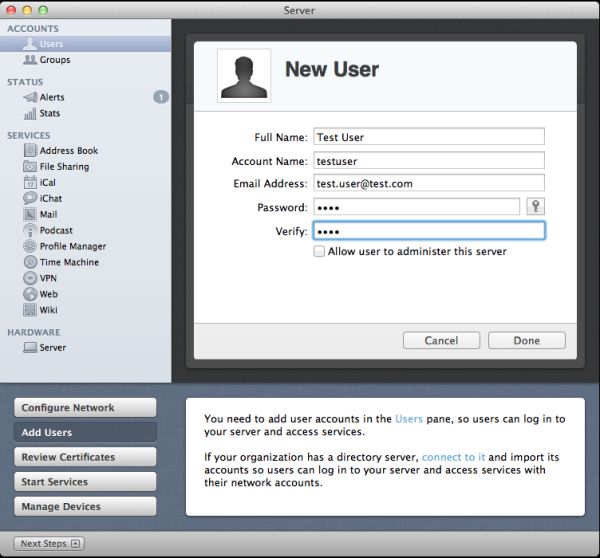
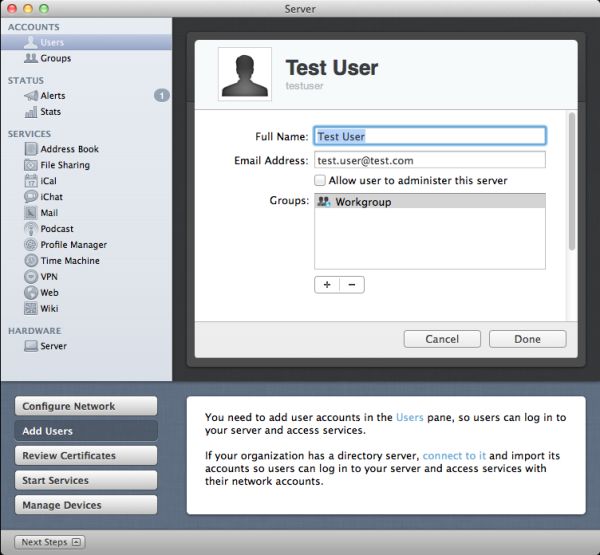
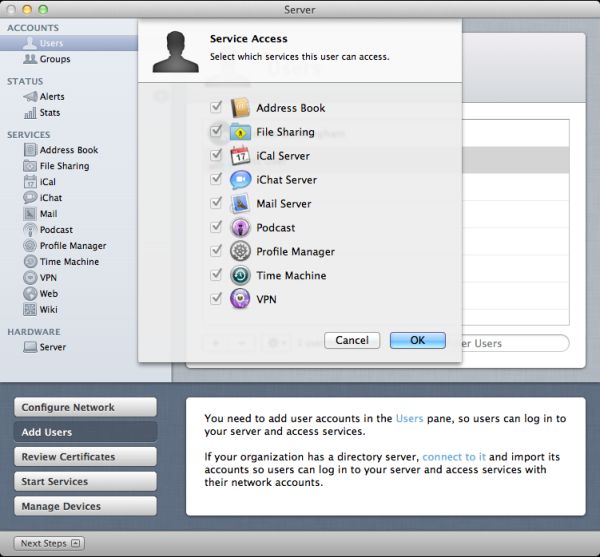
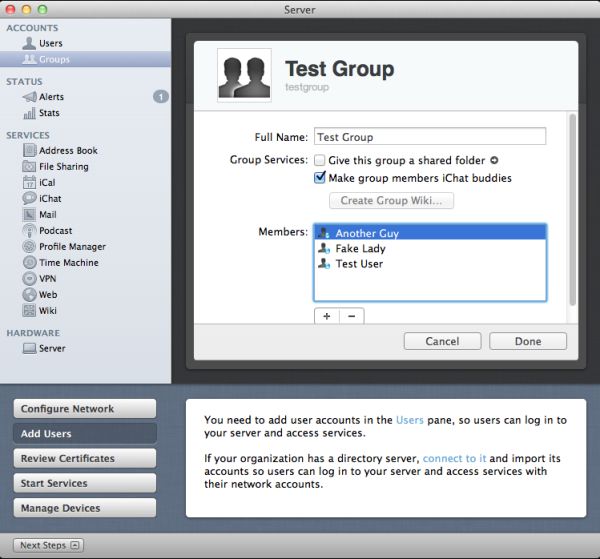
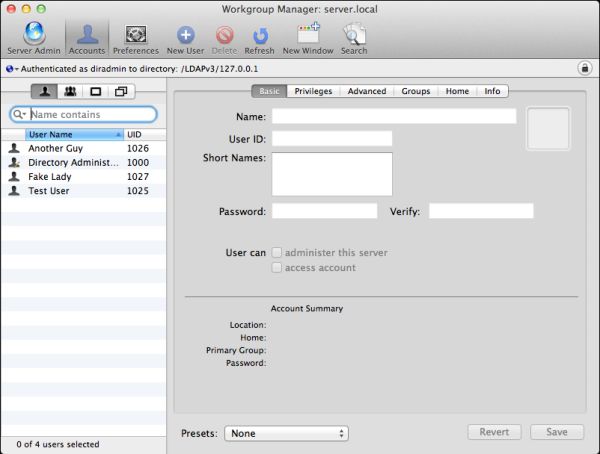
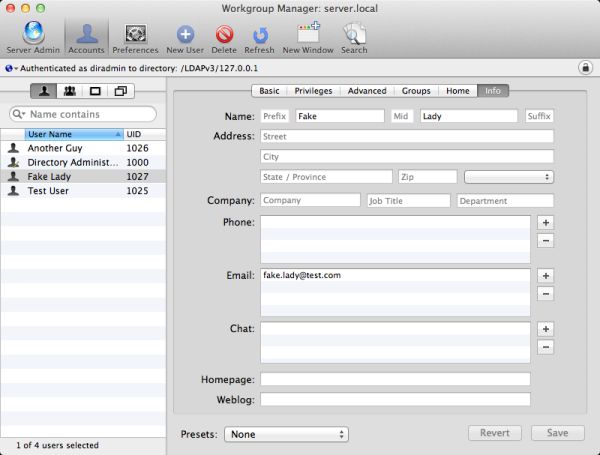
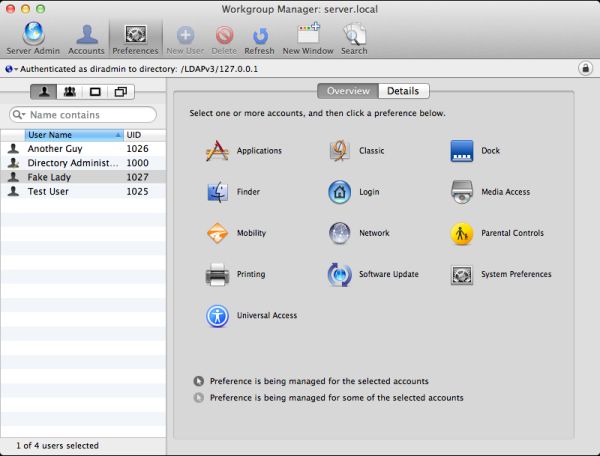








77 Comments
View All Comments
jedimed - Thursday, August 4, 2011 - link
Does anyone know if Lion Server supports any DLNA media streaming?jay2901 - Saturday, August 6, 2011 - link
sorry if this has been answered already...but if you aren't interested in legacy nt domain controller functionality, can you join a windows 7 pc to lion server's open directory? would love to use this in a mixed (50-50) environment with mac/pcs without needing active directory.ATOmega - Monday, August 8, 2011 - link
Such a limiting selection of hardware and functionality.Running a server, it makes more sense to take advantage of the strong updates and packages in Debian/Ubuntu and just run with that.
I mean, if you're crazy about the Apple hardware, go nuts! But it's clear what Apple really does with server is integrate a handful of half baked UIs with otherwise free software packages. Calling it a "server edition" changes little from an existential perspective.
I'll never understand the appeal of paying up to 3x more to get the same if not less...
tumme_totte - Tuesday, August 9, 2011 - link
Andrew, you say that Windows computers can't join the OD since a Lion OD Master can't be Primary Domain Master for Windows. But in the documentation Apple says something else:https://help.apple.com/advancedserveradmin/mac/10....
Can this be verified? Windows 7 machines can't be joined to Leopard Server (neither Server 2008) and I was hoping Lion would solve this.
Te-Moz - Sunday, August 14, 2011 - link
Andrew, you can set up device management with a self signed SSL certificate.Obviously it's 'nicer' to have one that's authority signed, but for us, we just need Lion server to control our Macs and iPads, push updates and provide some shared storage. (Educational setting)
Great article, and if you wanted to do one on setting up a golden triangle with Lion Server OD and Win AD, then I'm sure a lot of folk would fine that really helpful also. ;)
reese637 - Saturday, December 24, 2011 - link
Hi all. I'm a young tech enthusiast who likes to get his hands dirty in networks and servers and what not. As of now, I've been running our home network with two Time Capsule routers (acting as access points, web servers, backup drives, and file sharing), and many mac desktops and laptops (I believe four MacBooks and two iMacs). For a while now, I've been interested in upgrading to the Server edition of OSX, but I was afraid that it had too many requirements such as xserves, server domains, etc. Now that Lion Server seems to be a bit more consumer friendly and a lot cheaper, I was seriously thinking in upgrading. Would any of you please be able to let me know if there is anything else I need to buy/do in order for OSX Lion Server to actually work in my home? Thank you.Ron Blatto - Thursday, February 2, 2012 - link
I'm new to using any kind of server software and your guide is exactly what I was looking for.